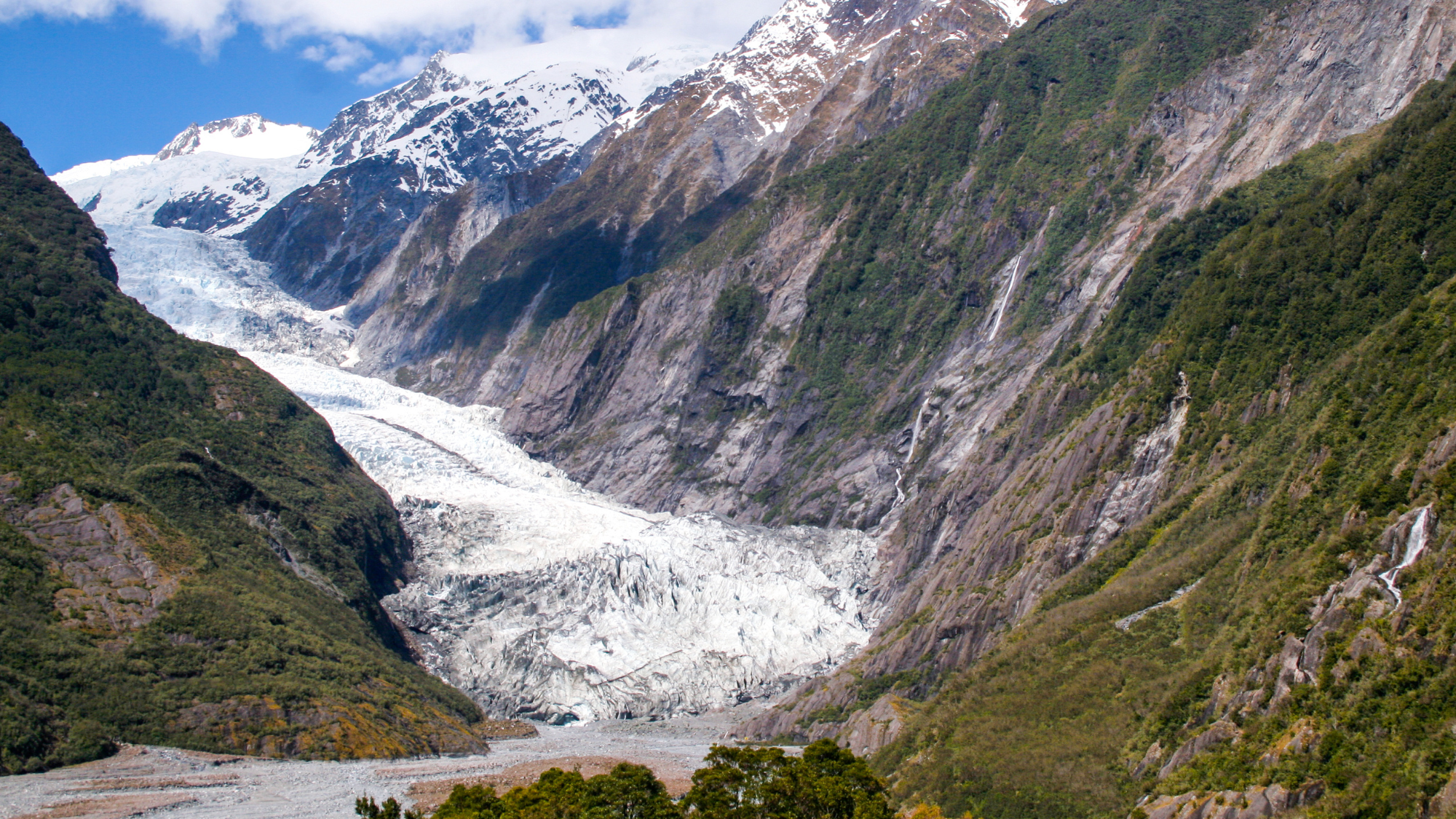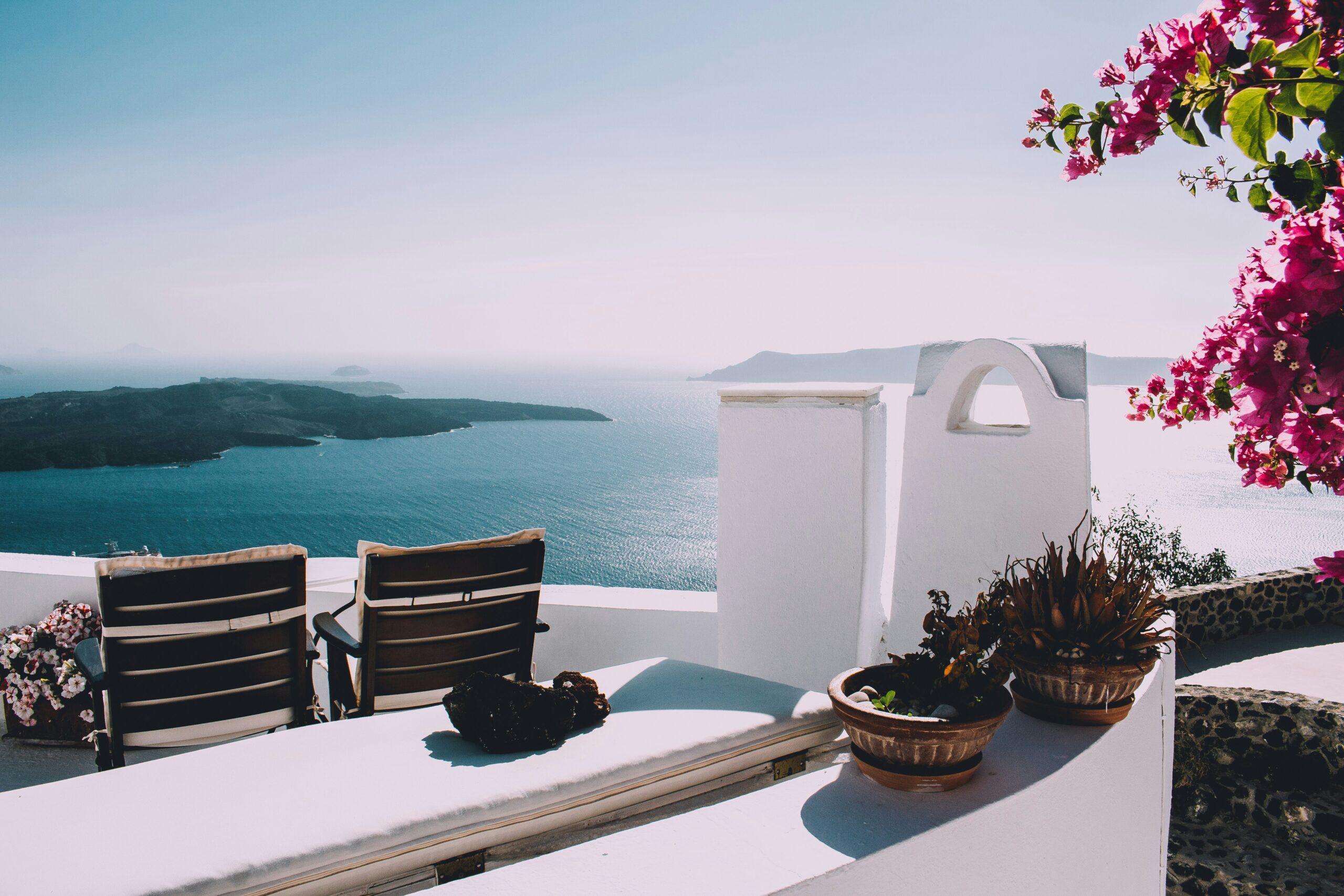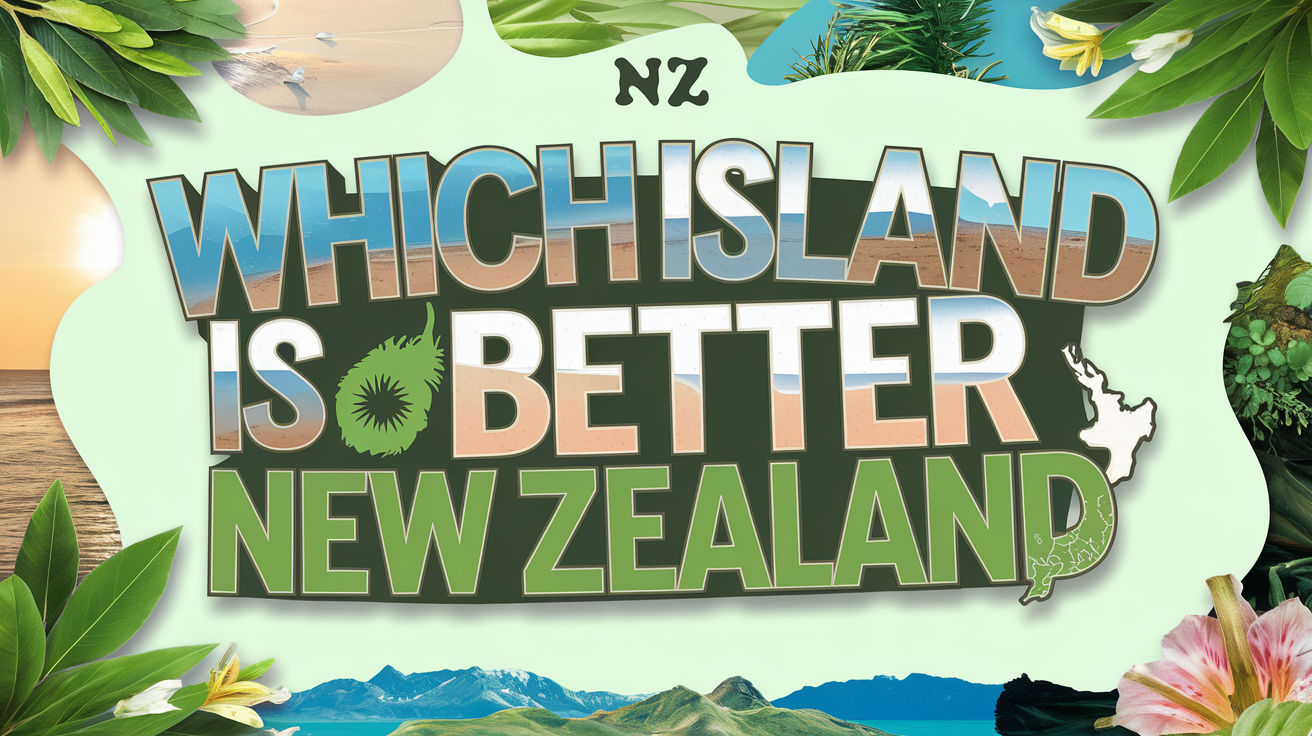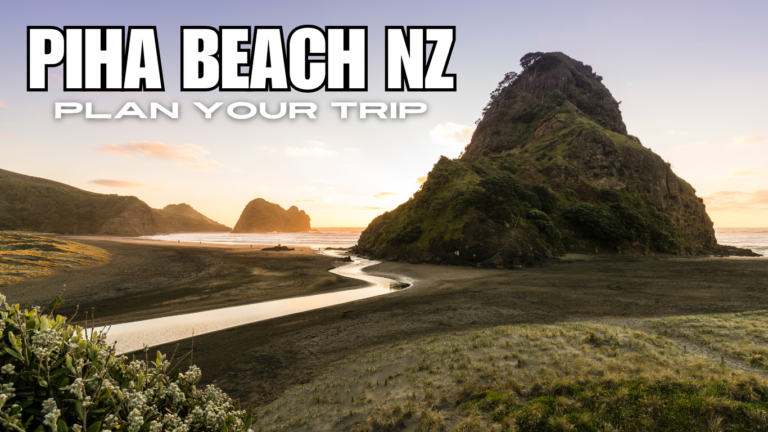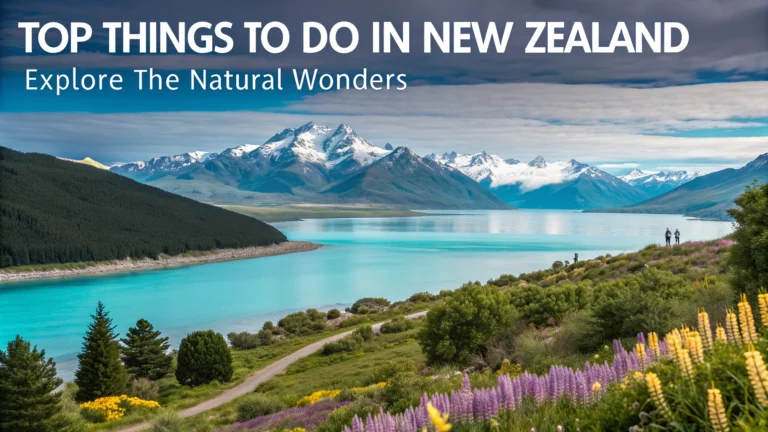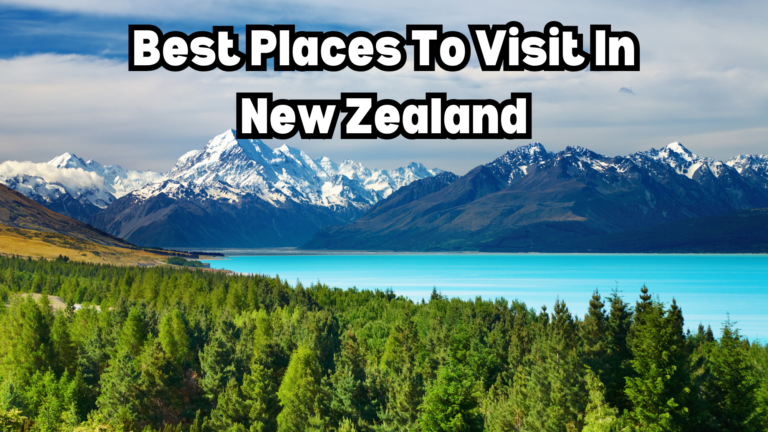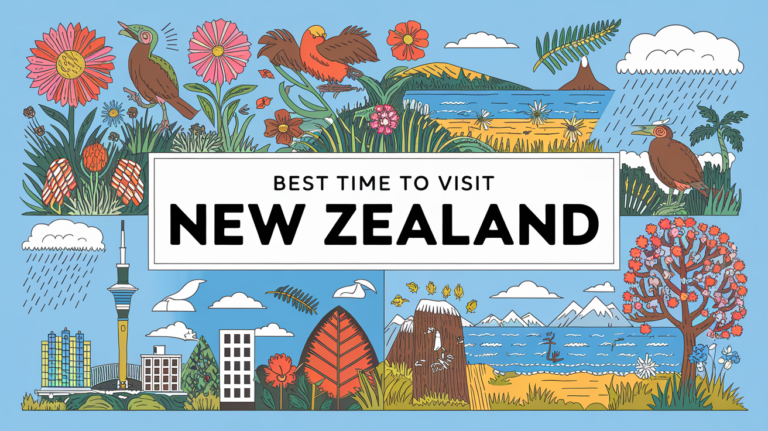Franz Josef Glacier
Franz Josef Glacier, located in New Zealand’s Southern Alps, is a remarkable natural wonder descending from 2,900 meters to 300 meters above sea level over just 11 kilometers. It’s one of the world’s steepest and fastest-moving glaciers, advancing up to 70 centimeters daily during peak periods. You’ll find its terminus in temperate rainforest, a rarity among glaciers. The glacier’s unique features include crevasses, seracs, and a dynamic terminal face. Climate change has dramatically impacted Franz Josef, causing substantial retreat and thinning in recent decades. Exploring this geological marvel offers insights into glacial formation, movement, and the effects of global warming on our planet’s ice masses.
Quick Facts
- Franz Josef Glacier is located in New Zealand’s Southern Alps, descending from 2,900 meters to 300 meters over 11 kilometers.
- It’s one of the world’s fastest-moving glaciers, advancing up to 70 centimeters per day during peak periods.
- The glacier’s terminus is uniquely situated in temperate rainforest, a rarity among glaciers worldwide.
- Visitors can explore the glacier through guided hikes, helicopter scenic flights, and self-guided valley walks.
- Climate change has significantly impacted the glacier, causing substantial retreat and thinning in recent decades.
Geography and Unique Features
Nestled in the Southern Alps of New Zealand’s South Island, Franz Josef Glacier descends from its névé at 2,900 meters above sea level to its terminus at just 300 meters.
This dramatic elevation change occurs over a mere 11 kilometers, making it one of the steepest glaciers in the world. You’ll find that Franz Josef is also one of the fastest-moving glaciers, advancing up to 70 centimeters per day during peak periods.
The glacier’s unique features stem from its location in a high-precipitation zone.
You’ll observe that it receives up to 30 meters of snowfall annually at its highest points, contributing to its rapid flow rate. The glacier’s terminus is situated in temperate rainforest, a rarity among glaciers worldwide. This juxtaposition creates a diverse ecosystem where you can witness ice formations alongside lush vegetation.
Franz Josef’s dynamic nature results in constantly changing ice structures.
You’ll encounter crevasses, ice caves, and seracs as you explore. The glacier’s retreat and advance patterns have created a distinct U-shaped valley, with steep valley walls that you can observe during your visit.
Glacier Formation and Movement
The formation and movement of Franz Josef Glacier are intrinsically linked to its unique geographical setting. You’ll find that its steep gradient and high snowfall contribute to its rapid flow rate, making it one of the fastest-moving glaciers in the world.
The glacier’s formation begins in the neve, where snow accumulates and compresses into ice over time. As the ice mass grows, gravity pulls it downslope, initiating the glacier’s movement.
Franz Josef Glacier’s distinctive features include:
- Crevasses formed by tension as the ice flows over uneven terrain
- Seracs, large ice blocks created by intersecting crevasses
- Terminal face, where the glacier meets the valley floor
- Lateral moraines, debris deposited along the glacier’s sides
- Ablation zone, where ice loss exceeds accumulation
You’ll observe that the glacier’s movement is influenced by factors such as temperature, precipitation, and bedrock topography. As it flows, the ice erodes the underlying rock, shaping the landscape.
The glacier’s rapid response to climate changes makes it an ideal subject for studying glacial dynamics and their environmental impacts.
Climate Change Impact
Climate change has substantially impacted Franz Josef Glacier in recent decades. You’ll observe that the glacier has experienced significant retreat and thinning due to rising temperatures and altered precipitation patterns.
Since the 1990s, the glacier’s terminus has retreated by over 800 meters, with an accelerated rate of loss in recent years.
You’ll notice that increased melting has led to the formation of proglacial lakes at the glacier’s base, further accelerating ice loss through calving.
The glacier’s mass balance has become increasingly negative, with accumulation zones shrinking and ablation zones expanding. This imbalance has resulted in a reduction of ice volume and surface area.
Climate models project continued warming in the region, which will likely exacerbate the glacier’s retreat.
You’ll find that these changes affect local ecosystems, water resources, and tourism.
The glacier’s retreat has exposed new land, altering habitats and sediment transport patterns.
Additionally, you’ll observe that the shrinking ice mass has implications for local hydrology, potentially impacting downstream water availability and hydroelectric power generation.
Exploring the Glacier
You can explore Franz Josef Glacier through guided hikes, helicopter tours, or self-guided valley walks.
Guided glacier hikes offer the opportunity to traverse the ice, potentially experiencing unique features like ice tunnels.
Helicopter scenic flights provide a broader perspective of the glacier and surrounding landscape, with some tours including glacier landings for ice climbing or hiking.
Guided Glacier Hikes
Setting out on a guided glacier hike at Franz Josef offers an unparalleled opportunity to explore this frozen wonder up close. These expertly led excursions combine helicopter access with on-ice exploration, providing you with in-depth insights into the glacier’s geological history and environmental significance.
Year-round availability guarantees you can experience the glacier’s majesty in any season, though winter months offer ideal conditions for stability and ice clarity.
You’ll be equipped with crampons and ice axes, receiving thorough instruction on their safe and effective use.
The hikes cater to various skill levels, from beginner-friendly routes to challenging treks involving ice climbing and crevasse navigation.
During your journey, you’ll encounter:
- Unique ice formations
- Glaciological phenomena
- Historical and geological context
- Environmental impact insights
- Hands-on experience with specialized equipment
Your guides will elucidate the intricacies of glaciology, helping you understand the dynamic nature of this ever-changing landscape.
As you traverse the glacier’s surface, you’ll gain a deeper appreciation for its role in the ecosystem and the factors influencing its evolution.
These guided hikes offer a blend of adventure and education, providing you with a thorough understanding of Franz Josef Glacier’s significance in both local and global contexts.
Helicopter Scenic Flights
For those seeking a bird’s-eye view of Franz Josef Glacier’s magnificent expanse, helicopter scenic flights offer an unparalleled perspective. Departing from Franz Josef township, these flights typically last 20-30 minutes, providing breathtaking views of the glacier’s blue-green ice and surrounding landscape.
You’ll soar over the glacier, witnessing its vastness and the intricate patterns carved by nature. The experience extends beyond Franz Josef, as you’ll also observe nearby glaciers like Fox Glacier and the Southern Alps. Some operators offer snow landings, allowing you to step onto the glacier itself for a closer look at its icy terrain.
To guarantee your safety and enjoyment, operators employ specialized equipment and experienced pilots.
| Flight Type | Duration | Snow Landing | Additional Views |
|---|---|---|---|
| Basic | 20 min | No | Limited |
| Extended | 30 min | Yes | Fox Glacier |
| Deluxe | 30 min | Yes | Southern Alps |
| Custom | Varies | Optional | Tailored |
These flights provide a unique opportunity to comprehend the glacier’s scale and its place within the broader alpine environment, offering insights that ground-based observations cannot match.
Self-Guided Valley Walks
While helicopter flights offer a panoramic perspective, self-guided valley walks provide an intimate, ground-level exploration of Franz Josef Glacier.
Several tracks cater to various fitness levels and time constraints, allowing you to experience the glacier’s dynamic environment firsthand.
The following self-guided walks are available:
- Franz Josef Glacier/Kā Roimata o Hine Hukatere track: 30-minute gentle walk
- Roberts Point Track: 5-6 hour challenging hike
- Alex Knob Hike: 3-4 hour moderate to challenging hike
- Franz Josef Glacier valley walk: Ends at a lookout 3000m from the glacier’s terminal face
Each trail offers unique viewpoints of the glacier and surrounding mountains.
The Franz Josef Glacier/Kā Roimata o Hine Hukatere track provides stunning vistas with minimal effort, while the Roberts Point Track rewards hikers with clear glacier views after a more strenuous journey.
The Alex Knob Hike features three separate viewpoints, offering an all-encompassing perspective of the glacial landscape.
It’s vital to note that the glacier’s rapid flow and frequent changes create a dynamic environment.
You should only attempt glacier walks with proper equipment and guidance, adhering to safety protocols to guarantee a secure and enjoyable experience.
Wildlife and Ecosystem
As you explore Franz Josef Glacier’s surroundings, you’ll encounter a unique ecosystem adapted to the harsh glacial environment.
Plants like the Mount Cook buttercup and kea, New Zealand’s alpine parrot, showcase remarkable adaptations to survive in this frigid habitat.
Conservation efforts focus on protecting these specialized species and maintaining the delicate balance of the glacier’s ecosystem in the face of climate change.
Unique Flora and Fauna
Biodiversity thrives in the unique environment surrounding Franz Josef Glacier. You’ll encounter a diverse array of flora and fauna adapted to the glacier’s harsh conditions.
The area’s microclimate supports a rich ecosystem, where species coexist in a delicate balance.
In the lower altitudes, you’ll find lush temperate rainforests dominated by native plant species.
As you ascend, vegetation shifts to alpine meadows and rocky outcrops.
The glacier’s unique flora includes:
- Rata trees with vibrant red flowers
- Native ferns like the silver fern (ponga)
- Alpine herbs such as the Mount Cook buttercup
- Mosses and lichens clinging to rocky surfaces
- Sub-alpine shrubs like the mountain neinei
The fauna in this region is equally diverse.
You might spot the rare kea, an intelligent alpine parrot, or the New Zealand falcon soaring overhead.
In the forest, you’ll encounter native birds like tui and bellbirds.
The glacier’s meltwater streams support various freshwater species, including the endangered longfin eel.
Additionally, you may observe introduced species like chamois and Himalayan tahr in the alpine areas, which have adapted to the challenging environment.
Glacial Habitat Adaptations
Franz Josef Glacier’s unique environment fosters remarkable adaptations among its wildlife and ecosystems. You’ll find the Powelliphanta snail thriving on the glacier’s rocky moraines, having evolved to feed on lichens and algae in this harsh terrain.
The surrounding rainforest hosts the kea, New Zealand’s native parrot, which has adapted to scavenge for food along the glacier’s edges.
At the terminal face, microorganisms including bacteria and fungi have adapted to extreme conditions, playing a vital role in organic matter decomposition.
The glacier’s meltwater streams support aquatic life such as the koura, a native freshwater crayfish that’s adapted to unpredictable water flows and temperatures.
Lake Wombat, the glacier’s glacial lake, is home to various aquatic plants and animals.
The weta, a large flightless insect, has adapted to the lake’s cold, oxygen-poor conditions.
These diverse adaptations highlight the resilience of species in the face of challenging glacial environments.
The Franz Josef Glacier‘s ecosystem showcases nature’s ability to evolve and thrive in extreme conditions, from microscopic organisms to larger wildlife, each finding its niche in this dynamic glacial habitat.
Conservation Efforts
While the Franz Josef Glacier‘s unique ecosystem faces numerous threats, concerted conservation efforts are underway to protect its diverse wildlife and habitats.
You’ll find that conservation organizations and government agencies are collaborating to implement strategies aimed at preserving the glacier’s delicate balance.
Key conservation initiatives include:
- Habitat restoration projects
- Wildlife monitoring programs
- Invasive species management
- Visitor impact mitigation measures
- Climate change adaptation strategies
You’ll notice that these efforts focus on maintaining biodiversity and ecosystem resilience. Researchers are conducting thorough surveys to assess population dynamics of endemic species, such as the kea and rock wren.
They’re also implementing predator control measures to protect vulnerable native fauna.
You’ll observe that conservation teams are actively working to restore degraded areas, replanting native vegetation and creating wildlife corridors.
They’re employing advanced technologies, including remote sensing and GIS mapping, to monitor glacial retreat and its impacts on surrounding ecosystems.
You’ll find that public education programs play a vital role in conservation efforts, raising awareness about the glacier’s ecological significance and promoting responsible tourism practices.
These initiatives aim to strike a balance between preserving the glacier’s natural integrity and allowing sustainable visitor access.
Cultural Significance
The cultural significance of Franz Josef Glacier extends beyond its natural beauty, encompassing both Māori and European historical narratives. You’ll find that Māori legends attribute the glacier’s formation to a young woman named Hinehukatere, who lost her lover in an avalanche. Her tears, frozen by the gods, are said to have created the glacier.
For European settlers, the glacier became a symbol of exploration and scientific discovery. You can trace its importance back to 1865 when geologist Julius von Haast named it after the Austrian Emperor Franz Joseph I.
This act tied the glacier to colonial history and international relations.
You’ll notice the glacier’s role in tourism development since the late 19th century, shaping the region’s economy and infrastructure. It’s become a cornerstone of New Zealand’s adventure tourism industry, attracting visitors worldwide.
The glacier’s retreat due to climate change has added another layer of cultural significance. You’re witnessing a shift in perception from a static landmark to a dynamic indicator of global environmental changes, influencing both scientific research and public discourse on climate issues.
Tourism and Local Economy
A staggering number of tourists flock to Franz Josef Glacier annually, with visitor counts soaring from 250,000 in 2008 to 700,000 in 2017. This influx of visitors has a significant impact on the local economy, driving growth and development in the region.
The glacier’s tourism industry offers a variety of attractions, including:
- Guided glacier walks
- Heli-hikes
- Scenic helicopter flights
- Accommodation options (hotels, motels, holiday parks)
- Local businesses (cafes, restaurants, shops)
These offerings cater to diverse tourist preferences and contribute substantially to the area’s economic prosperity. The town of Franz Josef has adapted to meet the demands of peak season tourism, expanding its accommodation capacity and service offerings.
Local businesses benefit directly from increased foot traffic and consumer spending, providing essential services and products to visitors.
The Franz Josef Glacier area has become a vital economic driver for the region, with tourism serving as a primary source of revenue. This economic boost has facilitated infrastructure improvements and created employment opportunities for local residents.
As visitor numbers continue to rise, the interdependence between the glacier’s natural appeal and the local economy becomes increasingly evident, highlighting the importance of sustainable tourism practices to preserve this valuable resource.
Safety Precautions
When visiting Franz Josef Glacier, you’ll need to prioritize safety by adhering to guided tour precautions.
You must participate in helicopter-assisted tours with experienced guides, as they’re equipped to navigate the glacier’s dynamic environment and provide essential safety equipment like ice axes and crampons.
You should also follow personal safety measures, including staying behind designated barriers during valley walks, heeding warning signs, and remaining vigilant for potential hazards such as jökulhlaups.
Guided Tours Precautions
For guided tours on Franz Josef Glacier, strict safety precautions are enforced to mitigate risks associated with the challenging environment. To participate, you must meet specific criteria:
- Be at least 12 years old
- Weigh a minimum of 35 kilograms
- Possess moderate fitness levels
- Be capable of hiking for several hours on uneven terrain
- Carry a 15-kilogram backpack
You’ll need to sign a medical and liability waiver, disclosing any pre-existing conditions that may affect your participation.
It’s essential to acknowledge and accept the inherent risks, including potential injury or death from glacial hazards, inclement weather, or helicopter crashes.
During the tour, you must strictly adhere to your guide’s instructions and remain within designated areas.
This precaution is imperative to avoid hazards such as crevasses and icefall.
The glacier’s dynamic nature demands constant vigilance and compliance with safety protocols.
Personal Safety Measures
Your personal safety on Franz Josef Glacier hinges on adhering to strict precautionary measures. When exploring the area, it’s vital to remain on marked and designated trails to prevent accidents and injuries.
For guided glacier hikes, you’ll need to wear crampons and ice axes to maintain stability on the icy surface. These tools are essential for preventing slips and falls that could lead to serious harm.
Weather conditions in the Franz Josef Glacier area can be unpredictable, so you must come prepared with appropriate attire. Bring waterproof and windproof clothing, along with sturdy shoes or hiking boots, to protect yourself from the elements.
Always follow the instructions of certified tour guides and staff during glacier-related activities to guarantee a safe experience.
Be vigilant of potential hazards such as crevasses, ice caves, and rockfall. Maintain a safe distance from these features to avoid accidents.
Your awareness of these dangers, combined with adherence to safety guidelines, will substantially reduce the risk of injury.
Best Time to Visit
Timing is essential when planning a visit to Franz Josef Glacier. The best season depends on your preferences and desired activities. Winter (June to August) offers reliable weather and stunning ice features, with daytime temperatures ranging from 5°C to 15°C (41-59°F). This period is ideal for viewing crevasses and ice caves.
Summer (November to February) provides warmer weather, with temperatures between 12°C and 25°C (54-77°F), perfect for outdoor activities like rainforest trekking and glacier hiking.
Consider these factors when choosing your visit time:
- Winter: Best for ice features and reliable weather
- Summer: Ideal for warmer temperatures and outdoor activities
- Spring/Autumn: Shoulder seasons with fewer crowds
- Year-round rainfall: Enhances scenic beauty
- Personal preferences: Weather tolerance and activity goals
Spring (September to November) and autumn (March to May) are shoulder seasons characterized by milder weather and smaller tourist numbers.
These periods may appeal to those seeking a balance between comfortable conditions and reduced crowding. It’s worth noting that rainfall occurs throughout the year, contributing to the area’s scenic beauty by swelling waterfalls and enhancing the lushness of the rainforest.
Your choice should ultimately align with your weather preferences and planned activities.
Photography Tips
Capturing the awe-inspiring beauty of Franz Josef Glacier requires careful planning and execution. To optimize your photographic results, you’ll want to weigh both timing and equipment.
Visit during the early morning or late afternoon when soft, golden light enhances the glacier’s textures and minimizes harsh shadows.
For equipment, you’ll need two primary lenses: a wide-angle (10-24mm) to capture the glacier’s vast expanse and surroundings, and a telephoto (70-200mm) for detailed shots of crevasses and ice formations.
Experiment with unique compositions by incorporating natural features like rocks, rivers, or trees, and vary your angles and perspectives to add depth to your images.
If you’re taking a helicopter tour, use a camera with robust image stabilization and set a fast shutter speed (minimum 1/1000th second) to counteract motion and guarantee sharp images.
For maximum flexibility in post-processing, shoot in RAW format to capture the full dynamic range of the scene.
Frequently Asked Questions
How Did Franz Josef Glacier Get Its Name?
You’ll find that Franz Josef Glacier was named by German explorer Julius von Haast in 1865. He chose to honor the Austrian Emperor Franz Josef I, reflecting the practice of naming geographical features after prominent figures during exploration expeditions.
What Is the Average Temperature on the Glacier?
You’ll find the average temperature varies substantially based on altitude and season. At higher elevations, it’s between -2°C to 5°C. Lower areas range from 2°C to 15°C. The overall annual average is approximately 4°C to 6°C.
Are There Any Accommodation Options Near Franz Josef Glacier?
You’ll find diverse accommodation options near the glacier. You can choose from affordable camping sites, luxury eco-resorts, budget-friendly hostels, cozy bed and breakfasts, and various hotels and motels. These cater to different preferences and budgets.
How Does Franz Josef Glacier Compare to Nearby Fox Glacier?
You’ll find Fox Glacier slightly longer at 13 km compared to Franz Josef’s 12 km. While both offer similar attractions, Franz Josef town provides more amenities. Fox Glacier features unique attractions like Lake Matheson’s scenic walk.
Can Visitors Drink Water From the Glacier’s Streams?
You shouldn’t drink directly from glacier streams. While they may appear pristine, they can contain harmful microorganisms and sediment. It’s advisable to treat the water through filtration, boiling, or purification methods before consumption for safety.
Conclusion
We’ve explored Franz Josef Glacier’s unique features, formation processes, and ecological significance. I highly recommend visiting this awe inspiring place. When you plan your visit, consider the glacier’s dynamic nature and photographic potential. Remember, your experience contributes to the local economy while offering insight into Earth’s glacial processes. Approach your visit with respect for this natural wonder’s fragility and grandeur.

